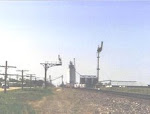 Early in 2004 (and a couple of times since) the Union Pacific Railroad brought one of their two operational steam locomotives to Kansas City for a short visit. These pictures were taken in January, on a cold but sunny morning at Union Station.
Early in 2004 (and a couple of times since) the Union Pacific Railroad brought one of their two operational steam locomotives to Kansas City for a short visit. These pictures were taken in January, on a cold but sunny morning at Union Station.Number 3985 is a Challenger, named for a landmark canyon along the UP in Wyoming. Steam engines are classified by the type and order of their wheels; this wheel arrangement is 4-6-6-4 (four pilot wheels; two sets of six linked driving wheels, each functioning as a separate engine; and four trailing or truck wheels under the cab and firebox), suitable for use in both passenger and freight service. She is a monster of a machine.
The 3900's were built in the early 1940's to help with wartime traffic. Diesel locomotives were already very much in use but not approved for manufacture because of war priorities. The government did approve some production of heavy steam locomotives for several roads and thus 3985 was assembled in 1943. If they were trying to save on steel, you have to believe they failed for there is a lot of metal in this old girl.
 Originally built to burn coal, many of these engines were converted to oil. The oil most railroads used was a thick, gel-like substance also used by the Navy in firing boilers for warships called "Number 6" or "6 Bunker" oil. More remarkable was the amount of water they consumed.
Originally built to burn coal, many of these engines were converted to oil. The oil most railroads used was a thick, gel-like substance also used by the Navy in firing boilers for warships called "Number 6" or "6 Bunker" oil. More remarkable was the amount of water they consumed. Wherever she goes, she totes along extra water and fuel, and a tool car in case there are mechanical issues. UP actually maintains a small steam department for 3985 and the 844, a wartime Northern (4-8-4) that also survived the scrap line. The men who are the steam department not only run these locomotives, but maintain them as well having learned to fabricate their own spare parts and diagnose problems which skilled craftsmen are no longer available to do.
Wherever she goes, she totes along extra water and fuel, and a tool car in case there are mechanical issues. UP actually maintains a small steam department for 3985 and the 844, a wartime Northern (4-8-4) that also survived the scrap line. The men who are the steam department not only run these locomotives, but maintain them as well having learned to fabricate their own spare parts and diagnose problems which skilled craftsmen are no longer available to do.
The silver-painted area is the firebox, in which a large fire burned underneath part of the boiler to convert water into steam. Fireboxes on these larger engines were as big as small rooms. Steam crews probably liked the fireboxes' radiant heat in the fall and winter but oh, how they must have roasted on warm, humid summer days crossing Nebraska.
The modern diesel-electric locomotives are cleaner, more efficient and more colorful, better to such a degree that they quickly killed off steam for good once World War II was over. But they lack the fierceness, the moving parts, the smoke, noise and personalities that steamers had. I only remember them for a few short years when I was very young, seeing Santa Fe steam pass by on the main freight line in El Dorado. But I sure miss watching those big wheels and rods work together, hearing the hiss of one passing at speed, and the drama of a Santa Fe 2-10-4 starting a heavy train when a signal cleared. Fun times.








No comments:
Post a Comment